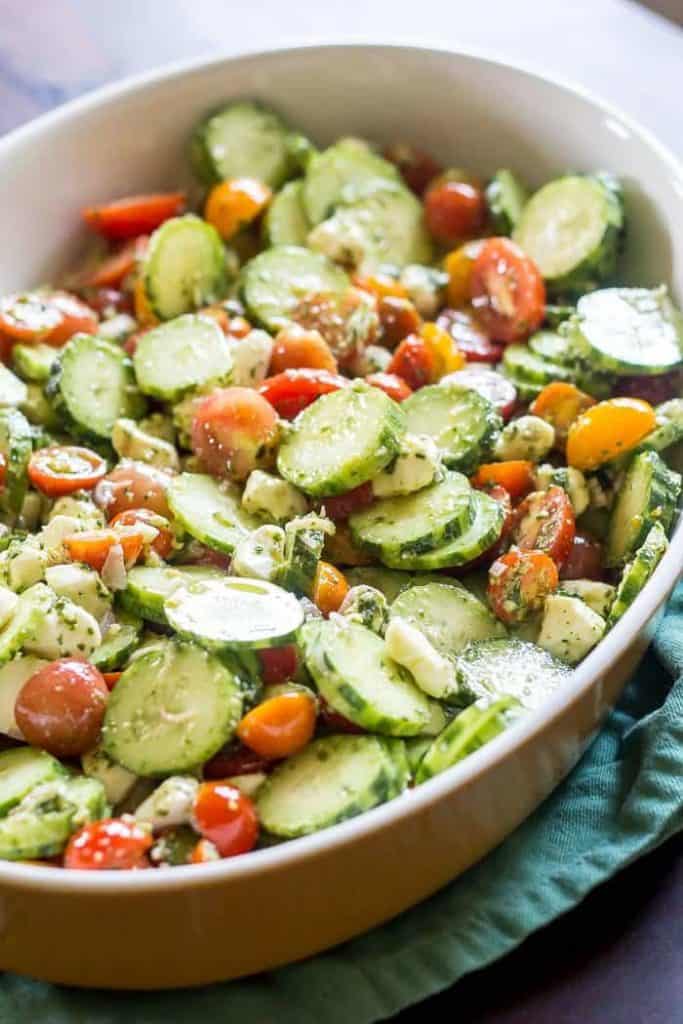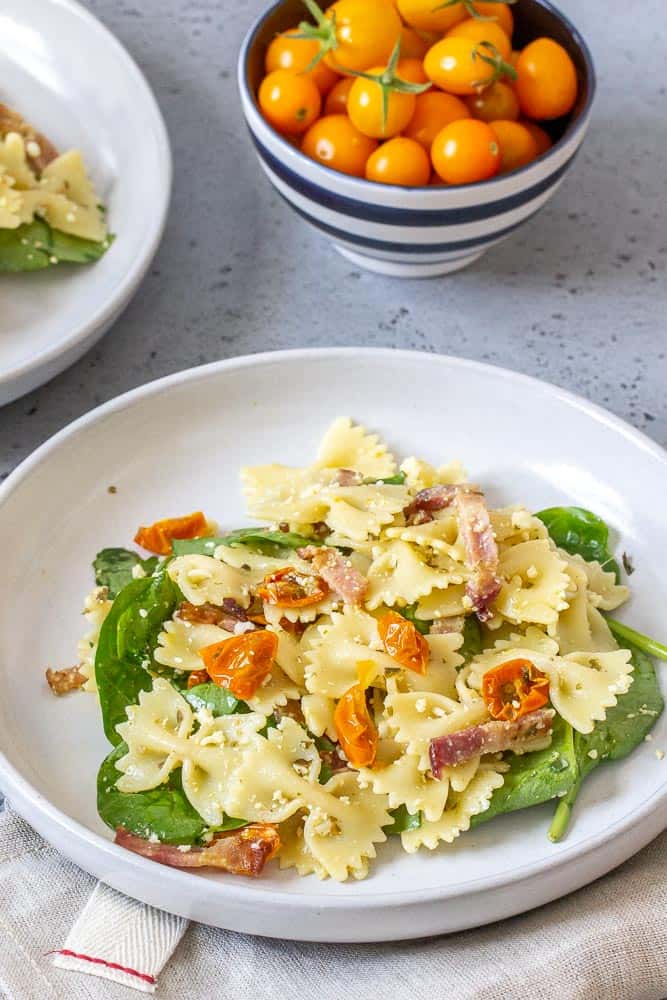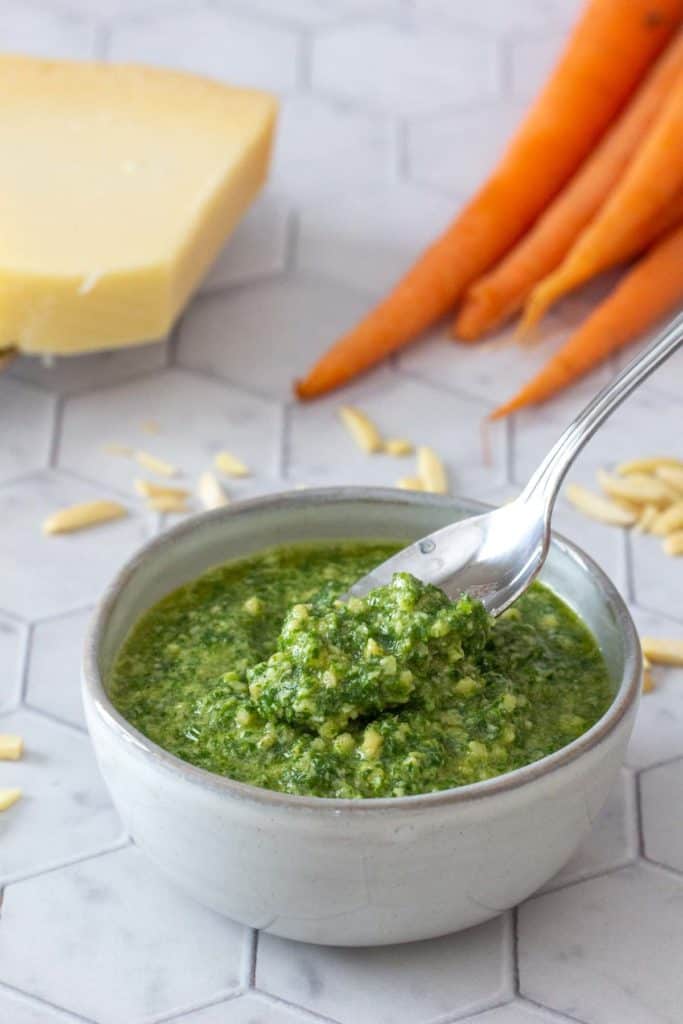This post contains affiliate links and may earn commissions on recommended products. As an Amazon Associate, I earn from qualifying purchases.
Homemade walnut pesto sauce brings you the best of summer. Use this easy-to-make condiment for pasta, salads, pizza, and more.
Is it even summer if you haven’t made pesto yet?
Every spring I plant basil in my herb garden. It’s hard to wait until I have enough to make pesto; those fragrant leaves are just too tempting to not be adding them to summer salads.
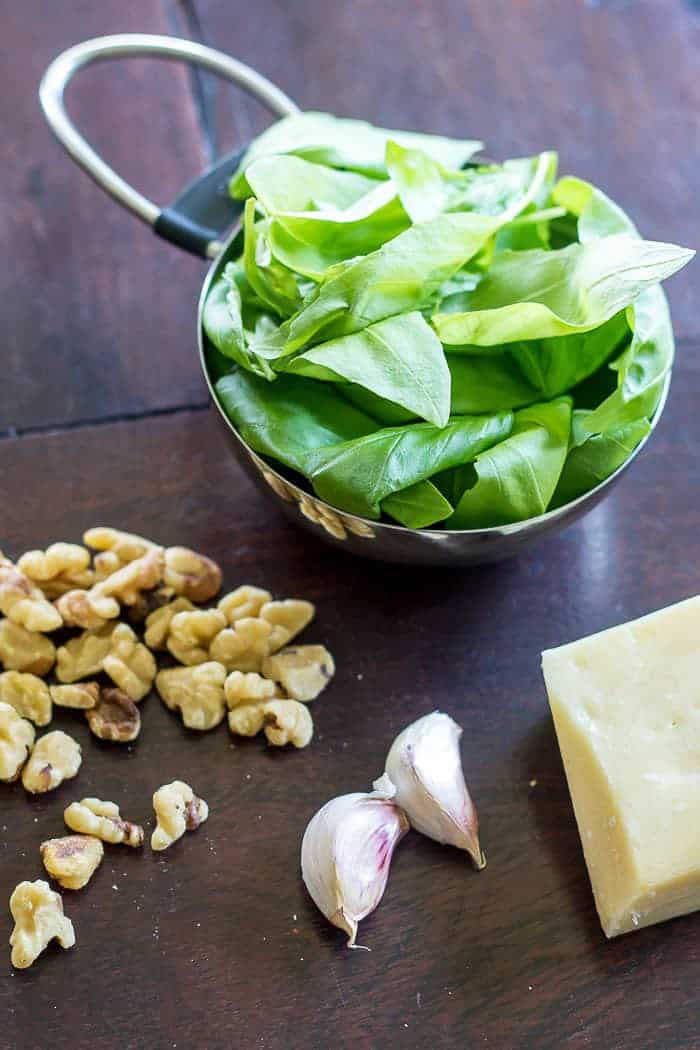
Sure, not everyone has a basil plant in their yard, but still — homemade pesto sauce is one of those summer requirements, like fresh tomatoes and juicy peaches. Both of which taste terrific with pesto. Nature knows what it is doing with the produce season cycles, folks.
Homemade pesto sauce is one of those foods that always feels fancy to me, and yet in truth it is ready in a matter of minutes. The step that takes the longest is grating the cheese. Or maybe scraping the sauce out of your food processor.
If you’re not a fan of pine nuts, this recipe uses walnuts instead. They are a bit milder in flavor and more economical!
Ingredients for walnut pesto
Full list of ingredients including quantities is located in the recipe card.
You’ll need:
Fresh basil leaves – You can use store-bought basil, or basil fresh from your garden. Either way, make sure it is clean and not wilted or browned.
Walnuts – English walnuts are the main kind of walnut found in grocery stores. If you want to use black walnuts, keep in mind that they are a stronger taste.
Garlic – You’ll want about 3 cloves of garlic.
Olive oil – Use a good-tasting olive oil.
Parmesan cheese – We use grated parmesan for pesto, not granules. I prefer freshly grated, but packaged parmesan will also do. Note that due to the anti-caking agents in bagged shredded cheese, you might need to add a little more liquid to your pesto.
Salt – To lift up all the flavors.
Lemon juice – Lemon balances the bitterness that can be found in walnuts, and also lightens the pesto.
A note on garlic
Garlic is one of those ingredients that varies quite a bit in size, and yet is silly to measure after chopping. Use your gut when it comes to determining how much garlic to use. The cloves we get tend to be a bit smaller, so I use extra. If you’re a garlic lover, do the same! Or if you prefer, you can use less. Don’t be afraid to adjust to your liking.
Equipment
A mini food processor works wonderfully for making pesto, but a larger-capacity is just fine as well.
You can also use a blender, though you will likely need to scrape down the sides more than with a food processor.
If you’re really into doing some extra work, a mortar and pestle will create a silky pesto.
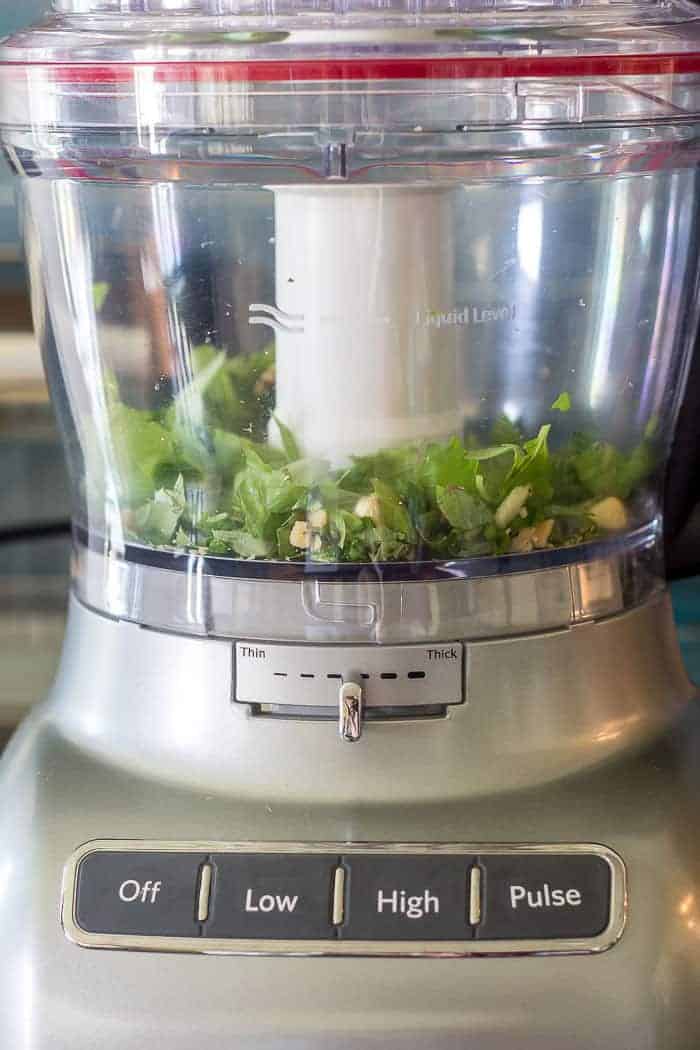
How to make this recipe
Combine the basil, walnuts, and garlic in the bowl of a food processor fitted with the chopping blade.
Pulse until everything is uniformly chopped. You may have to open the food processor and push the ingredients off the sides (turn off first!) to get it all nicely chopped.
Now, turn the processor on and slowly pour the olive oil in through the feeder tube at the top. Keep it going until it’s all nice and smooth.
Add in the parmesan, salt, and lemon juice, and pulse a few times to mix.
That’s it! Taste your pesto and add more salt or lemon juice if you like. You can also add pinch of ground black pepper or crushed red pepper flakes.
If you want your pesto thinner, you can add a small amount of water instead of adding more oil. Keep in mind, though, that the water could separate from the sauce a little as it sits.
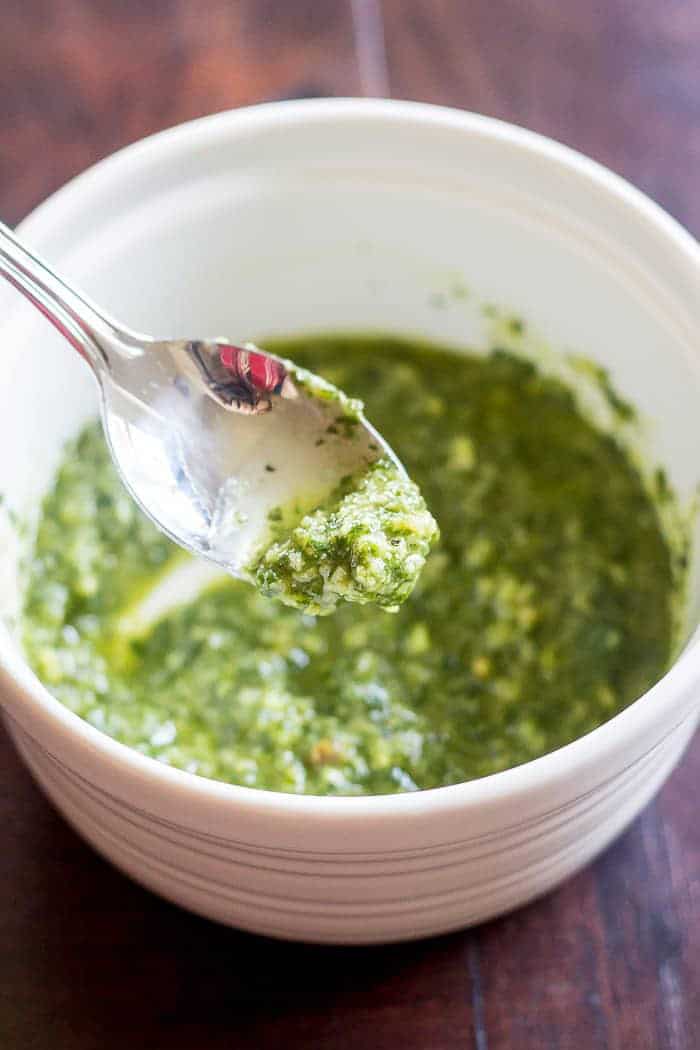
Recipe suggestions
Traditional pesto calls for pine nuts, but when I make homemade pesto sauce, I use whatever nuts I have on hand.
Usually this means walnuts, though I have also used almonds as in my recipe for carrot top pesto. You can substitute virtually any nut for pine nuts in pesto and it always turns out beautifully.
For the cheese, you can use parmesan, asiago, pecorino, or Grana Padano. Using other cheeses veers from the classic recipe, but again, I prefer to use the ingredients already available to me, so I encourage you to do the same.
Just stick to a hard, grate-able Italian cheese — no cheddar substitutions please!
Use kale or spinach for half the basil, especially if you only have a little basil on hand.
Storage tips
If you’re not using your pesto immediately, it needs to be stored in the refrigerator.
Scoop it into an airtight container. Add a thin layer of olive oil on top. This will help the pesto stay fresh and prevent browning. Close up the container and store for up to 1 week.
Toward the end of the summer I also make extra pesto to freeze it into ice cube trays, again with a bit of oil on top. Once frozen pop out the cubes and store them in freezer bags. You’ll have perfectly portioned sauce to enjoy through the winter!
FAQ
Uses for walnut pesto
You can use walnut pesto anywhere you’d use a traditional pesto sauce.
This pesto is great for making pesto shrimp or creamy pesto pasta. I love it as the base on chicken pesto pizza, too.
In the height of summer you’ve gotta make my cucumber tomato salad with pesto.
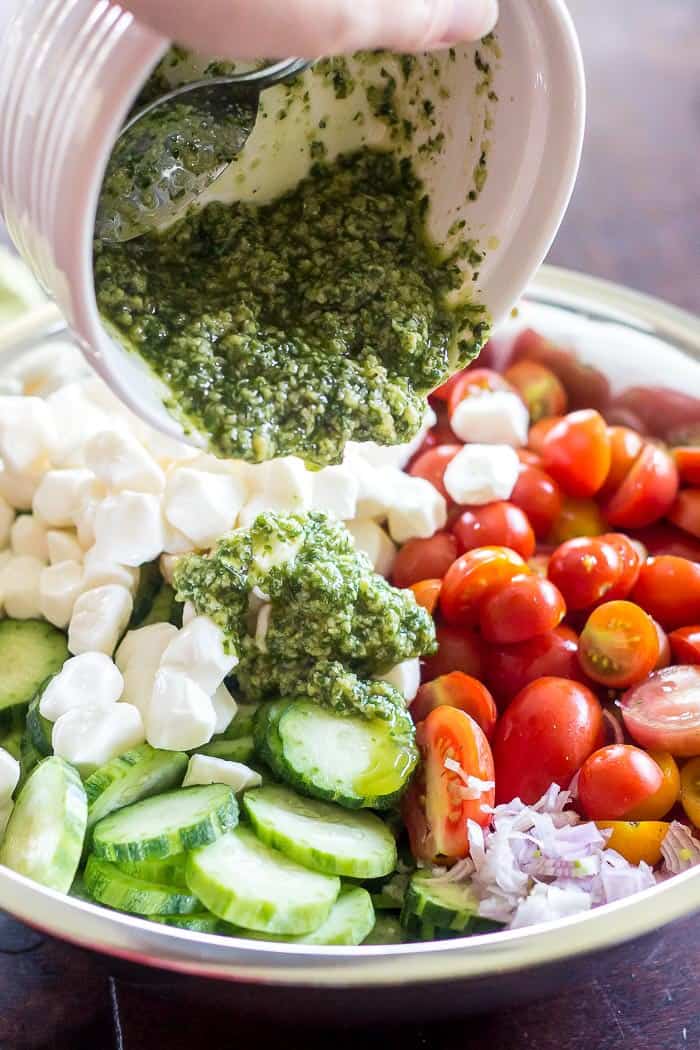
Try it as a spread for sandwiches like pressed Italian sandwiches, or mixed into mayonnaise for an herby aioli.
You’ll love this easy and versatile basil sauce!
Love this recipe? Please leave a 5-star review below!
It means so much when you enjoy my recipes, so let me know how it goes and leave a comment if you have any questions.
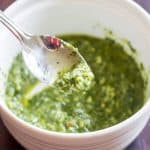
Homemade Walnut Pesto Sauce
Ingredients
- 2 cups fresh basil
- 2 tablespoons chopped walnuts
- 3 cloves garlic
- 1/2 cup extra-virgin olive oil
- 1/2 cup grated Parmesan cheese
- 1 teaspoon lemon juice
- Pinch salt
Instructions
- In the bowl of a food processor, combine basil, walnuts, and garlic. Cover and pulse until uniformly chopped.
- With the processor running, slowly pour in olive oil through the feeder opening until smooth.
- Stir in cheese, lemon juice, and salt. Taste and adjust seasoning if needed.
- Use immediately, or store in a covered jar in the refrigerator with extra olive oil on top.
Recipe Video
Notes
Recommended Products
Nutrition
Nutrition information is provided as a courtesy and is an estimate based on online calculators. Any nutritional information found on Stetted should be used as a general guideline only.

About Megan
I learned how to cook by exploring seasonal ingredients, and you can too! Meal time shouldn’t be stressful or complicated, and with fresh ingredients and easy methods, I’m here to help you enjoy the time spent in the kitchen. Read more…


